Best practices in retail wayfinding
by | 5 February 2020 2:58 pm
By Craig M. Berger
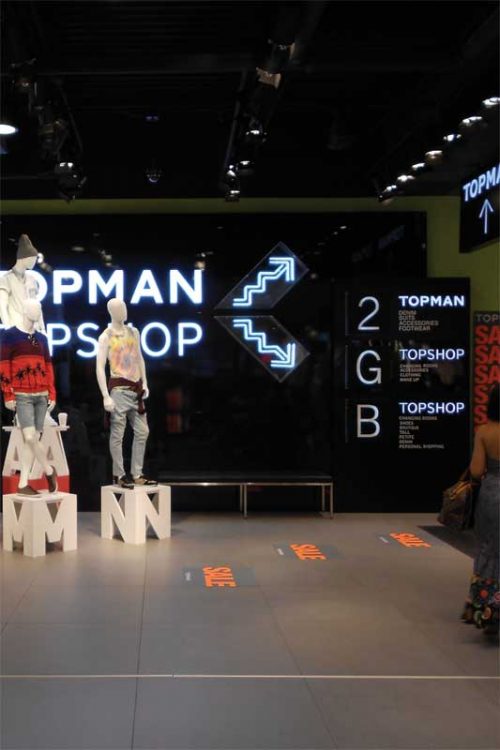 [1]
[1]Fashion retailer Topshop has employed a large toolkit of visual elements to support wayfinding including a hierarchy of illuminated elements such as neon icon signs, directories, and product displays.
The term ‘wayfinding’ has come a long way since Kevin Lynch first used it in an architectural context in his 1960 book, The Image of the City, where he defined wayfinding as the consistent organization of sensory cues in the external environment. In 1984, Romedi Passini’s book Wayfinding in Architecture expanded the definition to encompass a combination of sensory elements including visual graphics, tactile surfaces, and audible communications.
Wayfinding through visual communication, and particularly through signs, has grown as a field dramatically over the last three decades as part of the profession of environmental graphic design (EGD).
Today, there is considerable wayfinding expertise available when planning airports, hospitals, college campuses, and offices, among other facilities. The idea of a professional environmental graphic designer with skills in wayfinding design has been validated by multiple books, seminars, and educational programs.
Retail wayfinding, however, has defied being channelled into a specific discipline. Instead, the field has been treated as a component of multiple retail disciplines such as visual merchandising, experience design, and technology-driven adaptations like digital and mobile innovations, which are well entrenched with their own associations, academic institutions, and publications.
To understand best practices for wayfinding signs in retail, it is important to understand how each of these disciplines relates to wayfinding.
Retail wayfinding is heavily driven by analysis and best practices, which sets it apart from other initiatives. Profitable retailers tend to
be meticulous record takers and are constantly experimenting with approaches to attract customers. Given the complex interplay between merchandising, distribution, promotion, and customer experience, the best-managed retailers often have a firm hand on both traditional practices and new innovations.
The psychology of shopping
Retail wayfinding starts with the development of a strategy for managing the customer’s in-store experience. In his books Why We Buy and Call of the Mall, Paco Underhill introduced the idea that shopping is a cognitive science, and buyer outcomes can be improved by successfully manipulating the physical environment through store planning, placement of displays, and use of signs. This field has advanced into a more sophisticated understanding of how people behave in retail settings compared to internet-based environments. David Kepron’s book Retail (r)Evolution expanded on the idea
of measuring the customer experience by analyzing retail stores as social environments where the customer seeks entertainment in addition to buying products.
Store layout
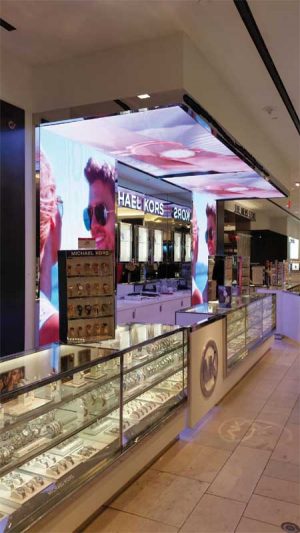 [2]
[2]A significant trend in store planning is the ‘store-in-a-store’ strategy, where a major brand represents its products by creating mini pavilions or entire sections with their own branding, fixtures, and displays.
Store planning is deeply rooted in tradition. Supermarkets and department stores have used similar planning formulas for decades. Signs, too, have closely conformed to practices honed over years of experience. The ‘racetrack’ and ‘grid’ plans developed by retailers in the ’50s and the sign practices used to support them are still in use today, with small modifications. Some companies have grown famous at breaking traditional store layout models and redefining the role of signs to support them, but tradition and experience still play an important role in influencing the overall customer experience.
One area where signs have grown to play an important role, even in traditional plan designs, has been with the installation of brand-specific product displays as visual cues in key areas of the store to attract attention. While this approach dates back to the World’s Fairs of the 19th century, in recent years companies have realized the importance of making these displays central to the customer experience. For example, early in its history, Ikea broke away from traditional store-planning methods with a format that combined practices from showrooms, supermarkets, and warehouses. The signs were revolutionary, adopting graphic approaches and typography from transportation facilities like airports and train stations and applying them to a retail environment.
Another major innovation is the use of a hierarchy of signs and displays that visually break the store into components—from large departments to specific product brands. While this trend started in smaller stores with vertical spaces like convenience stores and pharmacies, it has slowly become a key strategy in apparel and houseware stores today. For example, Topshop has employed a large toolkit of visual elements to support wayfinding including a hierarchy of illuminated elements such as neon icon signs, directories, and product displays.
Another significant trend in store planning is the ‘store-in-a-store’ strategy, where a major brand represents its products by creating mini pavilions or entire sections with their own branding, fixtures, and displays. While this approach has been used heavily in department stores for some time, it is now common in a variety of retail and non-retail environments—from banks to restaurants and airports.
Experience design
Experience design plays a dominant role in store planning and retail wayfinding methodologies. The term was first used in B. Joseph Pine II’s and James H. Gilmore’s 1999 book, The Experience Economy, to explain how companies have transformed from simply creating products and services to packaging experiences for customers. Today, dozens of business and design consultancies specialize in experience design, and their methods have completely transformed retail environments and store planning.
One specific area where experience design has had an enormous impact is reinforcing consistency between the wayfinding hierarchy of physical stores and websites, marketing materials, and signs. Reinforcing a consistent brand nomenclature and terminology across mediums is a core strategy for retailers looking to improve their brand image. For example, Walmart went through a complete renovation some years ago based on an experience analysis by Lippincott, a creative consultancy, which analyzed and improved the brand experience across mediums. Several improvements were made, including the design of interior sales signs and website formatting, which ensured these elements worked in conjunction to create an immersive shopping experience. These modifications proved successful, resulting in a seven per cent increase in store traffic among higher-income customers.
Effective retail signs
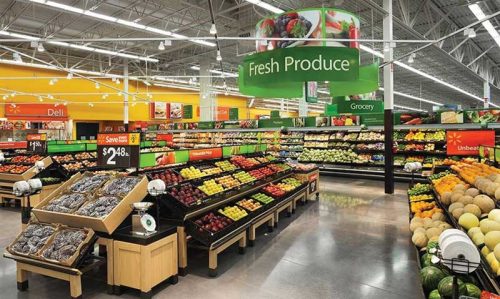 [3]
[3]Walmart went through a complete renovation some years ago. Several improvements were made, including the design of interior sales signs and website formatting, which ensured these elements worked in conjunction to create an immersive shopping experience.
For many years, signage was considered to be the most disposable component of retail stores, making use of inexpensive materials that could be changed frequently with minimal thought on scale, clutter, or impact beyond the immediate need to increase sales around items by identifying specific areas of the store. With recent efforts to improve the customer experience, many retailers now see signs as an important investment, worthy of the same care as other in-store fixtures. This has led to improvements in many areas:
Legibility
Retail outlets have a better understanding of legible signs and are making use of modelling software to analyze customers’ ‘viewing corridors’ when planning a store design. Today, signmakers are focusing heavily on legible typeface, scale, and contrast to enhance the customer experience.
Modularity and material quality
Modular sign systems have always been integral to stores, but some are becoming closely linked to store merchandise fixtures themselves, often becoming part of the same system. This approach is especially successful in enhancing the quality of store signs by matching them to the same material standards as fixtures.
Dimensionality
Retailers are beginning to see the many benefits of using channel letters, projecting signs, awnings, and other traditional outdoor signs in-store. These ‘store-in-a-store’ strategies often replace ‘flat’ indoor signs, making the interiors appear like urban streets or street fairs.
Illumination
Similarly, light-emitting diode (LED) technologies used for external illumination are now making their way inside stores. One leading trend has been the use of cove and soffit lighting to illuminate indoor signs, particularly those identifying the departments within a store.
In 2008, TD Canada Trust went through a long process to convert the acquired Commerce Bank branches to the TD Canada Trust brand, while maintaining and improving many of its approaches to enhance the retail wayfinding experience. The bank commissioned Toronto-based EGD firm Shikatani Lacroix to build on its existing transparent building design and develop a brand merchandising approach using print and digital signs. The project focused on developing specific ‘touchpoints’ that would have the biggest impact on the customer experience. Some of the key strategies included:
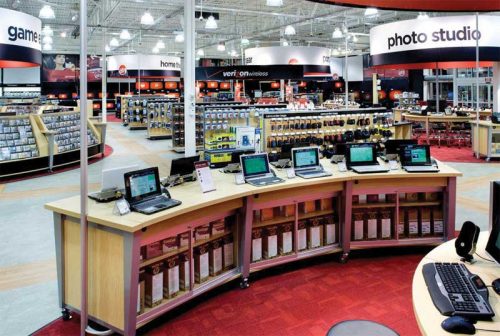 [4]
[4]Retail outlets are making use of modelling software to analyze customers’ ‘viewing corridors’ when planning a store design and are focusing heavily on legible typeface, scale, and contrast to enhance the customer experience.
Planning: The brand’s design can be likened to many fast-food restaurants, with a transparent front leading to the main teller counter with few visual or physical obstructions and a dominant drive-thru. Additional banking services are adjacent and also open to the outside.
Signs: Financial marketing products were placed in modular systems that closely aligned with the building’s window frames. Illuminated signs at key customer touchpoints such as the service desk, automated teller machines (ATMs), and lobby were carefully managed to minimize clutter.
Integrated displays: A tight graphic palette was maintained both for print and digital product marketing that were carefully integrated into fixtures, which supported the larger architectural palette. Newer locations also feature greater integration of digital signage into the architecture.
Window displays
Successful store navigation does not rely on signs alone, but requires a combination of architecture and displays to create a complete environment that directs and informs customers. In recent years, the removal of enclosed boxed windows has resulted in increased transparency of store architecture. As a result, displays have become a significant part of the overall store design and a primary supporter of wayfinding.
Designers use themed window displays to entice customers into stores, serve as landmarks, and promote specific sales. Large-format printing combined with modular panels and systems closely align displays with the overall wayfinding and communication demands of the store.
Another trend has been to make illuminated signs a key component of displays using retro methods like neon and light bulbs combined with dimensional and projected digital displays. Dynamic elements can transform displays into lively areas for public engagement.
Visual merchandising
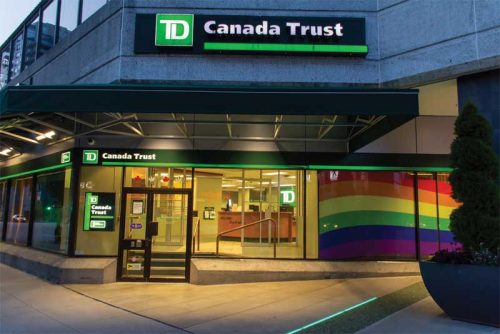 [5]
[5]TD Canada Trust’s design can be likened to many fast-food restaurants, with a transparent front leading to the main teller counter with few visual or physical obstructions and a dominant drive-thru.
The multibillion-dollar visual merchandising industry, comprising everything from fixtures to displays and digital point-of-purchase (POP) graphics can be thought of as a central operating system for retailers, following practices sensitive to customer actions and psychology. Signage in visual merchandising is often seen on two levels: (a) macro-level signs—that identify key areas of the store—are relatively fixed and cannot be changed easily; and (b) micro-level signs—POP, point-of-sale (POS), and promotion signs—that are flexible and adaptable to the environment.
Excellence in retail wayfinding is often achieved through a close correlation between how the macro and micro level of signs are managed, so as to achieve a seamless integration, rather than gaps in consistency and quality.
There has been considerable pressure for visual merchandisers to innovate in order to compete with online shopping, which has led to the use of multi-sensory elements like smell and touch, as well as digital and dynamic displays.
Marketing and promotion
Marketing departments have an outsized impact on wayfinding signs in the retail environment. With access to high-quality large-format printing, retailers are working to turn promotion into part of the wayfinding process through large-scale marketing materials integrated into lightboxes, fixtures, and window design. For example, retailer H&M regularly uses signs to promote new products and also to define spaces inside the store.
The growth in large-format graphics has also resulted in mergers between industries to better control brands in the environment. The packaging and fixture industries, for example, have combined their efforts to control how products are displayed in stores, with less need for intervention by in-store personnel. Trade show exhibit fabricators have also found opportunities in retail by developing pop-up stores and pavilions inside of existing stores.
Branded environments
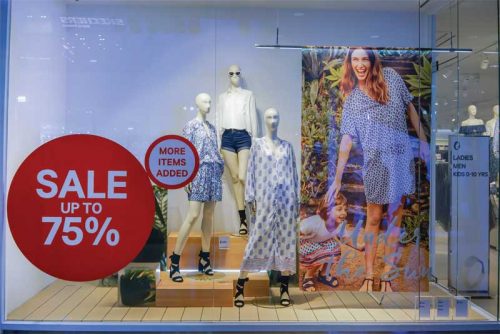 [6]
[6]Retailers are working to turn promotion into part of the wayfinding process through large-scale marketing materials integrated into lightboxes, fixtures, and window design.
American commercial interior designer Eva L. Maddox first coined the term ‘branded environments’ for practices that integrate branded communications into environmental design. Closely aligned with the discipline of experience design, branded environments treat retail spaces as the main driver of an organization’s brand. These environments have evolved into an exploration of architecture, materials, space, and landscape that reinforce corporate and institutional identities.
In the retail sector, this evolution has resulted in stores that share design attributes with other types of facilities such as airports, offices, and residences. As such, signs and wayfinding programs in this environment often have greater permanence and are closely integrated with their interiors.
Digital wayfinding
In the last decade or so, digital retail technology has grown into a multibillion-dollar industry that has touched every aspect of the buying and selling experience. Many retailers have worked to develop systems that link web purchasing, the movement of inventory, and in-store purchasing into one seamless system.
Interestingly though, extending these systems to visual signs in the environment has been a difficult task. Beyond front-of-store and key landmark displays, in-store networks have been difficult to develop due to high upfront costs and ongoing management.
One area where digital systems have started to make significant headway is in-store networks, particularly for content intensive retailers like electronics and communications. Interactive content allows retailers to understand customer behaviours and purchases, which further allows them to truly realize the value of digital investment.
Craig M. Berger is chair of the visual presentation and exhibition design department of the Fashion Institute of Technology’s (FIT’s) School of Art and Design and runs his own firm, Craig Berger Management Consulting, which assists fabricators, manufacturers, and institutions with design-based marketing and education strategies. This article is based on a project spearheaded by the Sign Research Foundation (SRF), a charitable non-profit organization that supplies academic research on effective sign strategies, systems, and codes and facilitates dialogue between architects, urban planners, developers, code officials, business owners, and designers to help support more navigable cities, thriving businesses, and strong urban identities. For more information, visit www.signresearch.org.
- [Image]: https://www.signmedia.ca/wp-content/uploads/2020/02/ndV_40RA.jpg
- [Image]: https://www.signmedia.ca/wp-content/uploads/2020/02/hu-lN8uQ.jpg
- [Image]: https://www.signmedia.ca/wp-content/uploads/2020/02/vfkg2KHw.jpg
- [Image]: https://www.signmedia.ca/wp-content/uploads/2020/02/BT8TDJyw.jpg
- [Image]: https://www.signmedia.ca/wp-content/uploads/2020/02/bigstock-new-Westminster-British-Colu-320603641.jpg
- [Image]: https://www.signmedia.ca/wp-content/uploads/2020/02/bigstock-H-m-Shop-At-Mega-Bangna-Bangk-246873247.jpg
Source URL: https://www.signmedia.ca/best-practices-in-retail-wayfinding/